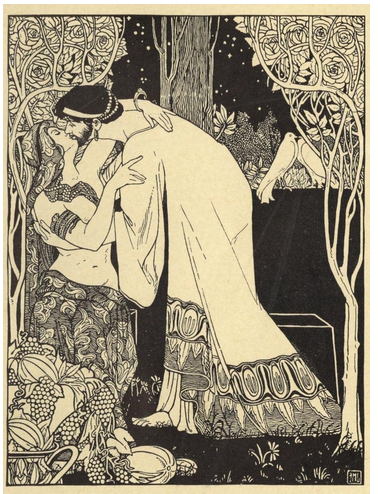Plants, and spices and oils of the Bible. Can they help?
On the internet, you will find many different fragrances for sale advertised as “plants of the Bible.” Is anything worth looking at? Always, because there is always something interesting to learn. Whatever takes me back to the happy times of Hebrew school and practice my Hebrew is always good.
What were the perfumes used in Biblical times? We can distinguish between those reserved for religious rites and the perfumes a person was permitted to use.
Plants were the primary source of alleviating diseases in Ancient Mesopotamia and Ancient Egypt. We can safely assume that plants (or products obtained from them, such as spices and incense), which had medicinal uses in Egypt and Mesopotamia, were also known in the land of Israel in Biblical times, even if these plants are not mentioned directly in the Bible. Many are still in our kitchen, but should we consider them “medicinal”?
Based on multi-disciplinary research, historians believe the Hebrew Bible was written between the 5th and 2nd centuries BC. The plants and fruits in the Hebrew Bible were named in Hebrew, and for some of them, we can only guess what they were: a job for archeologists, historians, and linguists. Modern research counts just 45 species as medicinal plants mentioned in the Bible. It’s important to note that many “classical plants of the Bible” resulted from mistranslation or botanical misidentification. Newer studies have tried to clarify identification, so question marks follow some of the names below.
What were the plants used in the Temple incense? Ketoret was the incense, i.e. sweet smoke, offered in the Temple in Jerusalem (Book of Exodus) and was a mixture of stacte (hebrew: nataph; opobalsamun? myrrh?), onycha (hebrew: shecheleth, labdanum?), galbanum and frankincense. This was restricted to religious use.
The anointing oil for priests included myrrh, cinnamon, calamus, and cassia.

Figure. Moses by E.M. Lilien.
For the perfumes used by the people, we can look at the Song of Songs; they include pomegranates, nard and saffron, calamus and cinnamon, myrrh and aloes.
From the Songs of Songs: “Thine ointments have a goodly fragrance; thy name is as ointment poured forth; therefore do the maidens love thee.”
Incidentally, there were no essential oils in Bible times. Essential oils are a modern invention that uses distillation to extract volatile chemicals from flowers or other plant material. But aromatic plants were used in religious ceremonies, and we can still enjoy them as extracts, essential oils, or, they came, leaves, roots, or whatever plant organ the aroma is strongest. Resins could be burned.
The benefits that medicinal plants of Bible times could give us have been greatly superseded by standardized extracts containing the effective chemicals responsible for the medicinal activity. Sin Actives uses many of these medicinal plants, now using purified extracts from the species richest in those chemicals. We are also careful not to use species in decline like
No fewer than 18 medicinal plants are mentioned in old Jewish post-Biblical sources, in addition to those in the Bible. They include fig (Ficus carica), nard (Nardostachys jatamansi), hyssop (Origanum syriacum), balm of Gilead (Commiphora gileadensis) and mandrake (Mandragora officinarum).


Figure. Illustrations by E.M. Lilien (1894-1925). Plants of the Bible.
Some plants from Biblical times
Acorus calamus, sweet reed, Hebrew (H): Kaneh
Allium cepa, onion, H: Batsal
Allium porrum, leek, Hebrew: Khatsir
Allium sativum, garlic, H: Shum
Anethum graveolens, dill
Artemisia sp. H: La’anah
Boswellia sp. , frankincense, H: Levonah
Capparis spinosa H: Tsalaf
Cedrus libani, cedar, H: Erez
Cinnamomum zeylanicum, cinnamon, H: Nees
Citrullus colocynthis, Colocynth.
Citrus medical, citron, H: Pri Ets Hadar
Commiphor sp., myrrh, H: Mor
Coriandrum sativum, coriander, H: Gad
Crocus sativus, saffron, H: Karkom
Cuminum cyminum, cumin, H: Kammon
Cupressus Sempervirens, cypress, H: Brosh
Juniperus sp., juniper, H: Ar’ar
Hordeum sp., barley, H: Se’orah
Linum usitatissimum, flax, H: Pishta
Mentha spp., mint, H: Gittin.
Myrtus communis, myrtle, H: Hadas
Nigella sativa, black cumin, H: Ketsakh
Olea Europaea, olive, H: Zay’it.
Phoenix dactylifera, date palm, H: Tamar
Punica granatum, pomegranate, H: Rimmon
Ricinus communis, castor Bean, H: Kikkayyon
Sinapis alba, mustard
Vitis vinifera, grape. H: geffen
We still use many of these plants because of their phytochemicals and benefits for human health. You will find grape seed extract, pomegranate and castor oil, frankincense, and more in our Skin Actives products.
As for perfumes, those extracts containing the volatile chemicals in aromatic plants of the Bible, use them whenever you wish to feel the romance of Biblical times without going through our ancestors’ challenging life experiences. I have these seven perfumes at home: cinnamon, galbanum, labdanum, myrrh, nard, frankincense, and storax. Like in the times, real or imagined, of Kink Solomon and the queen of Sheba. And celebrate with fermented grape juice, wine, just like they did.
Reference
Dafni A, Böck B. Medicinal plants of the Bible-revisited. J Ethnobiol Ethnomed. 2019 Nov 27;15(1):57. doi: 10.1186/s13002-019-0338-8. PMID: 31775790; PMCID: PMC6882220.
